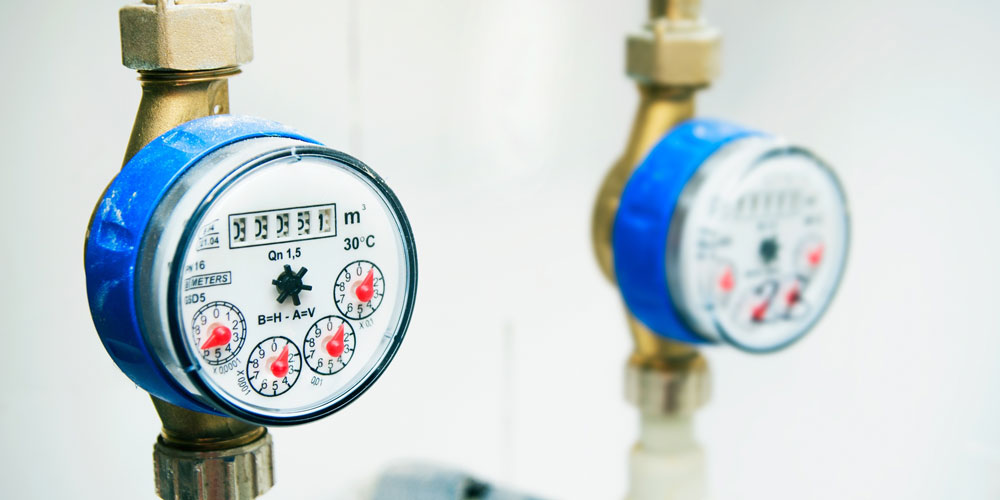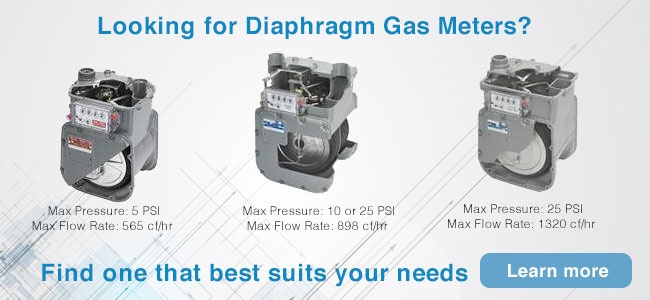Pulse outputs are used in metering when the direct reading of the dial is either not possible or not cost effective, and the intent is to read the meter remotely.
A pulse output in a meter represents a defined amount of flow passing through the meter (gas, water heat or electricity meter). The simplest and most common type of pulse is the one generated by a mechanical contact that either closes or opens on each turn of a sensor wheel. As one pulse equals one turn of the wheel, one pulse is equivalent to the amount of flow that caused that turn of the sensor wheel, like a turn on a dial in front of the meter.
Because the sensor wheels vary in the same proportion as the meter size the pulse rate also varies in a similar proportion. for instance:
A small 3/4" water meter may provide a pulse for every 10 litres (0.01cubic meter) or for every gallon, while a larger size 4" water meter may provide a pulse for every 100 litres (0.10 cubic meter) or for every ten gallons.
Similarly a medium size 250 MBTU gas meter may provide a pulse for every 2 cubic feet while an 800 MBTU gas meter may provide a pulse for every 10 cubic feet.
Other types of pulses are those generated with semiconductors (transistors) and can be represented optically or captured with the same data loggers that pick mechanical pulses. These electronic pulses are most commonly "Open Collector" or "Open Drain"
For Solid state meters; like electricity meters, ultrasonic water, and ultrasonic Thermal Energy meters, it is easier to provide the pulse output with and open collector. Because of the speed at which these pulses are generated, the resolution is increased.
For instance Electricity meters can generate a pulse for every 10 WH, or an equivalent of 100 pulses for 1 KWH of energy consumption.
The pulses are captured in a counter – called also a pulse-data logger that accumulates the pulse count and stores the count in memory, until pulled and transmitted to a reading device or a Data Collection Unit (DCU) where the total pulses over a period of time are converted to the reading of the consumption and can then be transmitted to the cloud where the consumption information is accessed remotely.
By being able to read the meters remotely, meters can be used for many applications, energy or consumption monitoring, benchmarking consumption of different sites, reporting, AMR or AMI, and in system controls.
A recommendation when using pulse output is to take additional care when wiring the pulse output cable, separating the conduit of the pulses from any other potential source of noise, using shielded pair, twisted wires. When using wireless radios to transmit the pulse count it is always recommended to perform a signal strength test prior to your deployment and being aware that any changes to the environment will affect your signal transmission. When pulse output meters are used for billing it is always good to perform a bi-annual reconciliation, between the total count and the accumulated read on the meter dial, in order to avoid large discrepancies that over time may appear because of the low resolution of the pulses, noise or other interferences that may affect the pulse count.
Even as technology improves, there is still room to use pulse output meters, because of their reliability, low cost and extensive options for data loggers and optical pulse readers in the market.
Applications of Pulse Outputs in Sub-meters
Because of the high resolution of pulses in electricity meters, they can be used for:
Peak Demand Management
A peak demand is a charge with a higher cost per kWh. This demand usually occurs when the needs are more significant, such as during the hot summer months when tenants want to turn on the air conditioners on full blast, 24/7, or cold winters when heaters are needed to stay warm.
Submeters allow tenants or end-users to avoid these cost increases by taking advantage of off-peak rates and preventing the cost increase. Utility companies built grids to support the maximum consumption; By increasing the cost of kWh consumed during certain periods, consumers will reduce their usage, which avoids overloading the grid.
Tenant Submetering
Tenant sub metering uses revenue-grade power meters to bill tenants for only the energy they consume within their rented space. These can be installed in each tenant's unit, and be read remotely. The information allows tenants to manage their consumption and reduce their consumption.
Knowing their energy costs in real-time enable consumers to lower their utility bills and allows them to invest in other energy-saving devices.
Energy Cost Allocation
With sub-metering allocation capabilities, energy costs are allocated to different processes and departments. The data collected allows building managers to understand where and when the energy is being consumed; Enabling them to take action, and find efficiencies and alternatives.


